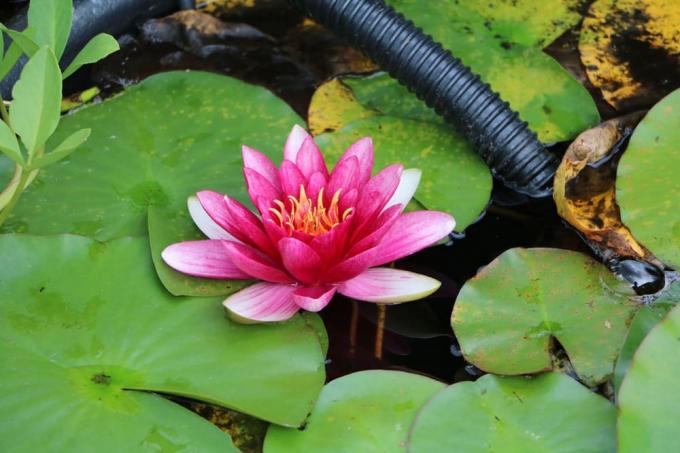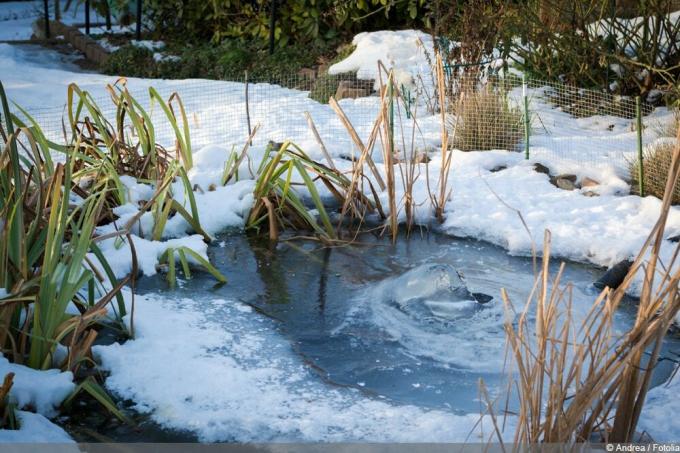

Table of contents
- Location
- Plant
- repot
- plant basket
Water lilies impress with their beauty and elegant flowers. The conditions are of great importance so that these graceful aquatic plants can settle in well and are in full bloom in a timely manner. The plant only thrives in the right container, the right body of water and the right depth of water. In addition, over time and as it grows, it will need to be repotted.
Location
Choosing the right location is crucial so that the water lilies can grow splendidly and form beautiful flowers. The distinctive flowers are purely aquatic plants and depend on appropriate conditions. First and foremost, these are not suitable for fast-flowing bodies of water, including rivers in particular. If you don't have your own pond, the graceful plants can also be planted in pots. The bottom of the body of water and its condition are also important, so that the water lilies can take root and feel comfortable in the long term. Since most types of water lilies are frost hardy, they can normally overwinter in the water.
- Calm to stagnant ponds and lakes are ideal
- Also grow in slow-flowing streams
- A sunny location is important, shade is not well tolerated
- Need at least 4-6 hours of sunshine per day
- Muddy ground is best
- Pay attention to lime-poor, nutrient-rich and humic properties
Plant
When planting water lilies, make sure that they are not planted directly in the bottom of the pond. Rather, the plants need a plant basket that gives them a good grip and is placed at a suitable water depth. The aquatic plants are available in specialist shops in a container that is filled with the right plant substrate and long-term fertilizer. The correct water depth depends on the species and variety and should be measured correctly. Therefore, the garden owner must inform himself in advance about the required depth. In addition, when buying, you should also pay attention to the growth strength, in this way the water lilies can adapt well to the environment. So that the water lily can grow well in the beginning, the plant basket should initially be in the shallow part of the water for the first few weeks. Only after this acclimatization phase is it advisable to move to the final location in a somewhat deeper zone of the pond.
- Do not plant directly in the pond bottom
- Buy with a plant basket, then position it at a suitable water depth
- Water depth is extremely important and varies by species
- Species for low water level need 20-50 cm
- Species for medium water level need 40-80 cm
- Species for deeper water level require 70-120 cm
- Plants should only be deep enough for leaves to float
- Also note the growth rate
- Only slow-growing varieties are suitable for small ponds and planters
- Only plant stronger growing varieties in larger ponds
Tip:
If new leaves form on the plant, then these are the signal for the draft after the acclimatization.
repot

After a few years at the latest, most water lilies are too big for the plant basket and have to be repotted. In this context, it makes sense to thin them out or even to share them entirely. Especially when the water lily's willingness to bloom has decreased after a few years, it should be divided and planted in a different location. First of all, a new plant basket must be selected for repotting, which should correspond to the growth characteristics of the variety. The basket needs a good base so that the potting soil is not washed into the water. In addition, the water lily is supplied with the necessary nutrients via the plant basket, which must be placed there.
- First place coarse jute or burlap in the plant basket
- The next layer is the plant substrate
- Garden or potting soil mixed with clay and sand is optimal
- Soil should contain little or no peat
- Special water lily soil is available in specialist shops
- Then comes the fertilizer
- Long-term fertilizer made of fertilizer balls, horn shavings or bone meal is ideal
- Cut off the thickest sections on the rhizome
- Finally, remove the water lily from the old pot and embed it in the new one
- Root ball should be flush with the top edge of the basket
- Cover well with substrate, also the spaces between
- Buds and a piece of the rhizome should protrude from the planting medium
- Place divided water lilies back in the pond one at a time
- Choose new locations
plant basket
In order to choose the right plant basket, the size, the root type and the vigor of the variety are decisive. The basket must be able to withstand the conditions in the water for several years without being damaged. Pay attention to plant baskets with fine meshes, which prevent the substrate from being washed out. Nevertheless, these meshes should still be wide enough so that the roots can spread out in the pond bottom without any disturbing obstacles.
- Plant baskets made of a non-rotting material, such as plastic, are ideal
- Bulbous, thickened roots need a narrow and deep plant basket
- Rhizome-like roots need a flat and wide plant basket
- Basket sizes from 2 to 10 liters are suitable for small ponds
- For a medium-sized pond, the basket size is 5-10 liters
- For a large pond, 15-30 liters in the basket are perfect
 garden editorial
garden editorial I write about everything that interests me in my garden.
Learn more about floating plants - care

Duckweed in the pond | What to do with duckweed?
Duckweed sometimes settles in the pond all by itself and then likes to get the upper hand. This text explains why this is so and how it can be removed.

Shell flower, water lettuce: care from A-Z
The mussel flower (Pistia stratiotes) is also known under the name water lettuce. It can be cultivated in ponds and aquariums and is extremely decorative. But what do you have to pay attention to when it comes to care? Our guide shows it.

Dwarf water lily - care, planting & wintering
A garden pond is only complete and a feast for the eyes with water lilies. For certain ponds, the dwarf water lily offers the only solution for flowery pond design. The plant expert explains the most important details in terms of plants, care and wintering.

Planting a sea jug in the pond: instructions | Care from A-Z
The sea jug thrives as a decorative floating-leaf plant with floating stems that root in the ground. In these instructions you can read how to take unconventional growth into account when planting in the garden pond. A guide from A-Z explains how the home advantage of the European aquatic plant is reflected in the uncomplicated care.

Overwintering water lilies - caring for pond plants in winter
What would a garden pond be without decorative aquatic plants in it? Especially since pond and marsh plants not only have a decorative effect, but also keep the pond clean and ensure the necessary oxygen supply. However, not all species are hardy and therefore require special attention in the cold season.

Hornblatt (hornwort) - care and propagation
The horn leaf, which is also popularly known as hornwort, is one of the plants that can often be found in aquariums or garden ponds. The easy-care aquatic plant with its long, leafy tendrils is not only a beautiful sight, it also serves as an indicator of the quality of the water.
